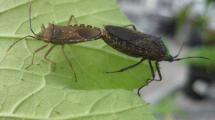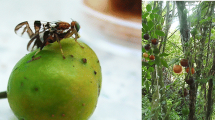Abstract
The ecological and social bases of the mating system of the seed-feeding bug, Dysdercus bimaculatus(Hemiptera: Pyrrhocoridae), were studied in the lab and in aggregations at the host tree, Sterculia apetala(Malvales: Malvaceae), in Panama. On theoretical grounds, two factors are predicted to be of importance in determining the evolution of male mating tactics in Ms species: the operational sex ratio and the probability that undefended females will mate with other males, subjecting the gametes of deserters to sperm competition. Results of a study of a related species suggested that sperm displacement is probably substantial. Adult sex ratios at numerous sites were significantly male biased, and females whose mates were removed remated before oviposition (i. e., sperm utilization). These results predict that a mate defense tactic is likely to be superior to a nondefense tactic. The biological significance of the parameters is supported by observations that captive pairs often remained in copulafor several days, until just before oviposition. However, substantial variation in copulation duration was also observed, and possible causes of this variation are considered. Causes of male biased adult sex ratios were investigated by monitoring demographic changes within a single aggregation over 2 months. Both female juvenile and adult mortality rates were greater than male. In addition, dissections of reproductive adults showed that the flight muscles of females, but not males, had histolyzed, so that female reproduction is physiologically limited to a single site. Greater rates of immigration among both mature and young males suggests that an excess of males may also be found in the populations of bugs that subsequently colonize other host plants, so that female scarcity is typical of aggregations in all stages of development. The evolution of sex-limtied flight muscle histolysis may be explained by greater patchiness of females than males as mating resources, plus a lower energetic benefit/cost ratio of histolysis for males.
Similar content being viewed by others
References
Altmann, J. (1973). Observational study of behavior: Sampling methods.Behavior 49: 309–317.
Ballard, E., and Evans, M. G. (1928).Dysdercus sidae, Mont., in Queensland.Bull. Entomol. Res. 18: 405–432.
Carroll, S. P. (1988). Contrasts in the reproductive ecology of temperate and tropical populationsof Jadera haematoloma (Hemiptera: Rhopalidae), a mate-guarding insect.Ann. Em. Soc. Am.
Darwin, C. (1874).The Descent of Man, and Selection in Relation to Sex, 2nd ed., A. L. Burt, New York.
Derr, J. A. (1980a). The nature of variation in life history characters ofDysdercus bimaculatus (Heteroptera: Pyrrhocoridae), a colonizing species.Evolution 34: 548–557.
Derr, J. A. (1980b). Coevolution of the life history of a tropical seed-feeding insect and its food plants.Ecology 61: 881–892.
Dingle, H. (1966). The effect of population density on mortality and sex ratio in the milkweed bug,Oncopeltus, and the cotton stainer,Dysdercus (Heteroptera).Am. Nat. 100: 465–470.
Dingle, H., and Arora, G. (1973). Experimental studies of migration in bugs of the genusDysdercus.Oecologia 12: 119–140.
Edwards, F. J. (1970). Endocrine control of flight muscle histolysis inDysdercus intermedius.J. Insect Physiol. 16: 2027–2031.
Fuseini, B. A., and Kumar, R. (1975). Ecology of cotton stainers (Heteroptera: Pyrrhocoridae) in southern Ghana.Biol. J. Linn. Soc. 7: 113–146.
Gatehouse, A. G., and Hall, M. J. R. (1976). The effect of isolation on flight and the pre-oviposition period in unmatedDysdercus superstitiosus.Physiol. Entomol. 1: 15–19.
Harwalkar, M. R., and Rahalkar, G. W. (1973). Sperm utilization in the female red cotton bug.J. Econ. Entomol. 66: 805–806.
Janzen, D. H. (1972). Escape in space bySterculia apetala from the bugDysdercus fasciatus in a Costa Rican deciduous forest.Ecology 53: 350–361.
Janzen, D. H. (1983).Costa Rican Natural History, University of Chicago Press, Chicago.
Kirkendall, L. R., and Stenseth, N. C. (1985). On defining “breeding once.”Am. Nat. 125: 189–204.
MacArthur, R. H., and Wilson, E. O. (1967).The Theory of Island Biogeography, Princeton University Press, Princeton, N.J.
McLain, D. K. (1980). Female choice and the adaptive significance of prolonged copulation inNezara viridula (Hemiptera: Pentatomidae).Psyche 87: 325–336.
Meyers, J. G. (1927). Ethological observations of some Pyrrhocoridae of Cuba.Ann. Entomol. Soc. Am. 20: 279–300.
Nair, C. R. M., and Prabhu, V. K. K. (1985a). The role of feeding, mating and ovariectomy on the degeneration of indirect flight muscles ofDysdercus cingulatus (Hemiptera: Pyrrhocoridae).J. Insect Physiol. 31: 35–39.
Nair, C. R. M., and Prabhu, V. K. K. (1985b). Entry of protein from degenerating flight muscles into oocytes inDysdercus cingulatus (Heteroptera: Pyrrhocoridae).J. Insect Physiol. 31: 383–388.
Parker, G. A. (1970). Sperm competition and its evolutionary consequences in the insects.Biol. Rev. Cambridge Philos. Soc. 45: 525–568.
Parker, G. A. (1974). Courtship persistence and female-guarding as male time investment strategies.Behaviour 48: 157–184.
Sillén-Tullberg, B. (1981). Prolonged copulation: A male “post-copulatory” strategy in a promiscuous species,Lygeaus equestris (Heteroptera: Lygaeidae).Behav. Ecol. Sociobiol. 9: 283–289.
Sivinski, J. (1978). Intrasexual aggression in stick insects,Diapheromera veliei andD. covilleae, and sexual dimorphism in the Phasmatodea.Psyche 85: 395–406.
Sivinski, J. (1980). The effects of mating on predation in the stick insectDiapheromera veliei Walsh Phasmatodea: Herteronemiidae).Ann. Entomol. Soc. Am. 73: 553–556.
Sivinski, J. (1983). Predation and sperm competition in the evolution of coupling durations, particularly in the stick insectDiapheromera veliei. In Gwynne, D. T., and Morris, G. K. (eds.),Orthopteran Mating Systems: Sexual Competition in a Diverse Group of Insects, Westview Press, Boulder, Colo., pp. 147–162.
Srivastava, U. S., and Bahadur, J. (1958). Observations on the life history of the red cotton bug,Dysdercus cingulatus (Hemiptera: Pyrrhocoridae).Ind. J. Entomol. 20: 228–234.
Sweet, M. H. (1964). The biology and ecology of the Rhyparochrominae of New England (Heteroptera, Lygaeidae). Part II.Entomol. Am. 43: 1–124.
Thornhill, R. (1980). Sexual selection within mating swarms of the lovebugPlecia nearctica (Diptera: Bibionidae).Anim. Behav. 28: 405–412.
Thornhill, R., and Alcock, J. (1983).The Evolution of Insect Mating Systems, Harvard Press, Cambridge Mass.
Van Doesburg, P. H., Jr. (1968). A revision of the new world species ofDysdercus Guerin Meneville (Heteroptera, Pyrrhocoridae).Zool. Verhandel. 97: 1–215.
Vrydagh, J. M. (1941). Etude sur la biologie deDysdercus superstitiosus F. (Hemiptera).Publications de L'Institute National pour L'Etude Agronomie du Congo Belge, Serie Scientifique, No. 24.
Walker, W. F. (1980). Sperm utilization strategies of nonsocial insects.Am. Nat. 115: 780–799.
Wing, S. R. (1985). Prolonged copulation inPhotinus macdermottii with comparative notes onPhotinus collustrans (Coleoptera: Lampyridae).Fla. Entomol. 68: 627–634.
Yamamura, N. (1986). An evolutionarily stable strategy (ESS) model of postcopulatory guarding in insects.Theor. Pop. Biol. 29: 438–455.
Author information
Authors and Affiliations
Rights and permissions
About this article
Cite this article
Carroll, S.P., Loye, J.E. Male-biased sex ratios, female promiscuity, and copulatory mate guarding in an aggregating tropical bug,Dysdercus bimaculatus . J Insect Behav 3, 33–48 (1990). https://doi.org/10.1007/BF01049193
Accepted:
Issue Date:
DOI: https://doi.org/10.1007/BF01049193




